(四)k8s实战-服务发现
一、Service
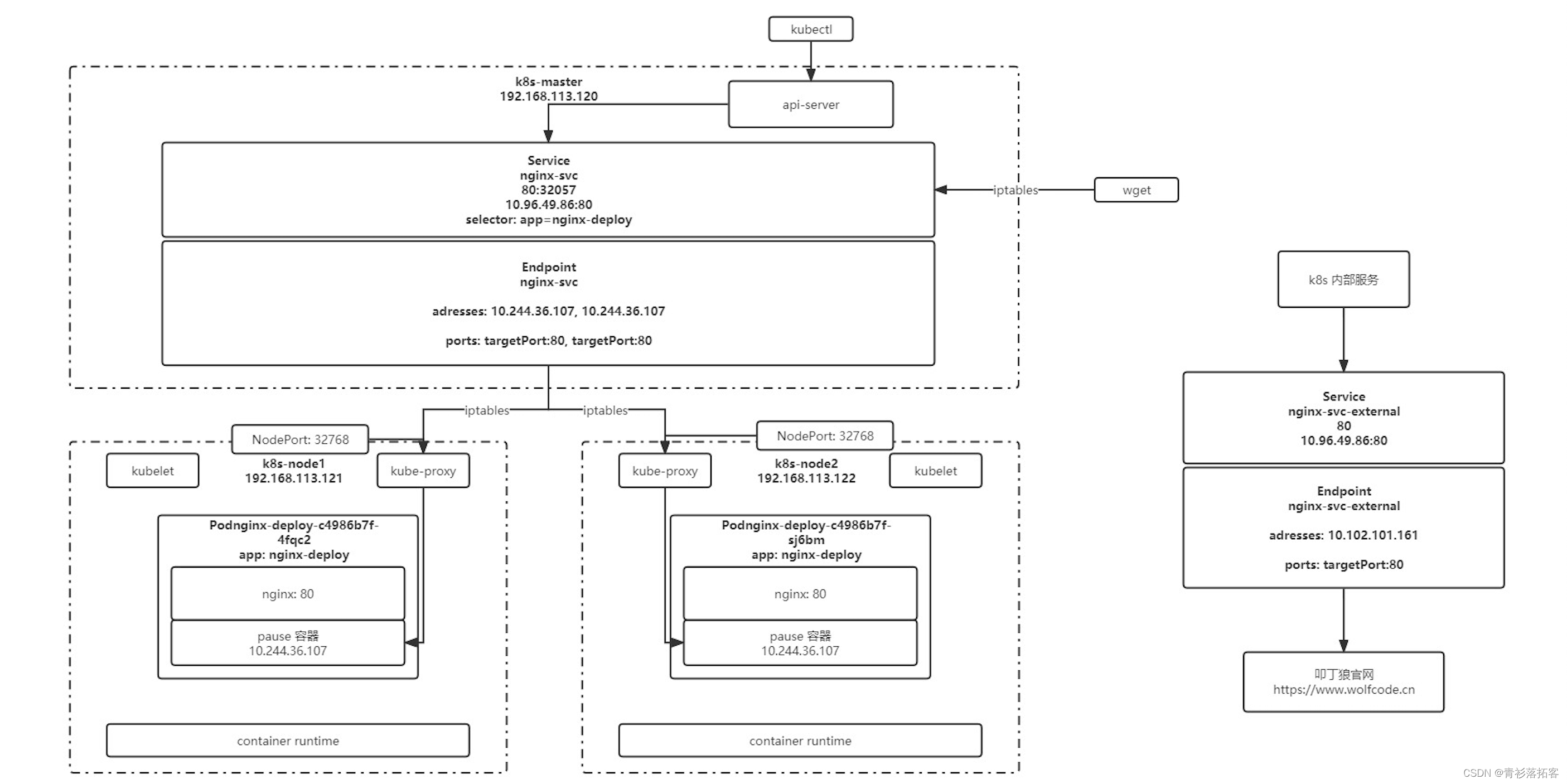
1、配置文件
apiVersion: v1
kind: Service
metadata:name: nginx-svclabels:app: nginx-svc
spec:ports:- name: http # service 端口配置的名称protocol: TCP # 端口绑定的协议,支持 TCP、UDP、SCTP,默认为 TCPport: 80 # service 自己的端口targetPort: 9527 # 目标 pod 的端口- name: httpsport: 443protocol: TCPtargetPort: 443selector: # 选中当前 service 匹配哪些 pod,对哪些 pod 的东西流量进行代理app: nginx
2、命令操作
# 创建 service
kubectl create -f nginx-svc.yaml# 查看 service 信息,通过 service 的 cluster ip 进行访问
kubectl get svc # 查看 pod 信息,通过 pod 的 ip 进行访问
kubectl get po -o wide# 创建其他 pod 通过 service name 进行访问(推荐)
kubectl exec -it busybox -- sh
curl http://nginx-svc# 默认在当前 namespace 中访问,如果需要跨 namespace 访问 pod,则在 service name 后面加上 .<namespace> 即可
curl http://nginx-svc.default
3、代理 k8s 外部服务
实现方式:
- 编写 service 配置文件时,不指定 selector 属性
- 自己创建 endpoint
endpoint 配置文件:
apiVersion: v1
kind: Endpoints
metadata:labels:app: nginx # 与 service 一致 name: nginx-svc-external # 与 service 一致 namespace: default # 与 service 一致
subsets:
- addresses:- ip: 120.78.159.117 # 目标 ip 地址ports: # 与 service 一致- name: webport: 80protocol: TCP
各环境访问名称统一
访问 k8s 集群外的其他服务
项目迁移
4、反向代理外部域名
apiVersion: v1
kind: Service
metadata:labels:app: nginx # 与 service 一致 name: nginx-svc-external # 与 service 一致
spec:type: ExternalNameexternalName: www.wolfcode.cn # 目标 域名
5、常用类型
ClusterIP
只能在集群内部使用,不配置类型的话默认就是 ClusterIP
ExternalName
返回定义的 CNAME 别名,可以配置为域名
NodePort
会在所有安装了 kube-proxy 的节点都绑定一个端口,此端口可以代理至对应的 Pod,集群外部可以使用任意节点 ip + NodePort 的端口号访问到集群中对应 Pod 中的服务。
当类型设置为 NodePort 后,可以在 ports 配置中增加 nodePort 配置指定端口,需要在下方的端口范围内,如果不指定会随机指定端口
端口范围:30000~32767
端口范围配置在 /usr/lib/systemd/system/kube-apiserver.service 文件中
LoadBalancer
使用云服务商(阿里云、腾讯云等)提供的负载均衡器服务
二、Ingress
1、安装 ingress-nginx
1、安装 Helm
# 下载Helm二进制文件
wget https://get.helm.sh/helm-v3.10.2-linux-arm64.tar.gz
# 解压
tar -zxvf helm-v3.10.2-linux-amd64.tar.gz
#在解压目录中找到helm程序,移动到需要的目录中
mv linux-amd64/helm /usr/local/bin/helm
# 测试是否安装成功
helm version# 添加仓库
helm repo add ingress-nginx https://kubernetes.github.io/ingress-nginx
# 查看仓库列表
helm repo list
# 搜索 ingress-nginx
helm search repo ingress-nginx
2、下载安装包
helm pull ingress-nginx/ingress-nginx
3、配置参数
# 将下载好的安装包解压
tar xf ingress-nginx-xxx.tgz
# 解压后,进入解压完成的目录
cd ingress-nginx# 修改 values.yaml
镜像地址:修改为国内镜像
registry: registry.cn-hangzhou.aliyuncs.com
image: arm64v8/google_containers/nginx-ingress-controllerregistry: registry.cn-hangzhou.aliyuncs.com
image: arm64v8/google_containers/kube-webhook-certgen
tag: v1.5.0hostNetwork: true
dnsPolicy: ClusterFirstWithHostNet修改部署配置的 kind: DaemonSet
nodeSelector:ingress: "true" # 增加选择器,如果 node 上有 ingress=true 就部署
将 admissionWebhooks.enabled 修改为 false
将 service 中的 type 由 LoadBalancer 修改为 ClusterIP,如果服务器是云平台才用 LoadBalancer
修改后的values.yaml
## nginx configuration
## Ref: https://github.com/kubernetes/ingress-nginx/blob/main/docs/user-guide/nginx-configuration/index.md
#### Overrides for generated resource names
# See templates/_helpers.tpl
# nameOverride:
# fullnameOverride:## Labels to apply to all resources
##
commonLabels: {}
# scmhash: abc123
# myLabel: aakkmdcontroller:name: controllerimage:## Keep false as default for now!chroot: falseregistry: registry.cn-hangzhou.aliyuncs.comimage: google_containers/nginx-ingress-controller## for backwards compatibility consider setting the full image url via the repository value below## use *either* current default registry/image or repository format or installing chart by providing the values.yaml will fail## repository:tag: "v1.5.1"#digest: sha256:e5c4824e7375fcf2a393e1c03c293b69759af37a9ca6abdb91b13d78a93da8bd#digestChroot: sha256:e0d4121e3c5e39de9122e55e331a32d5ebf8d4d257227cb93ab54a1b912a7627pullPolicy: IfNotPresent# www-data -> uid 101runAsUser: 101allowPrivilegeEscalation: true# -- Use an existing PSP instead of creating oneexistingPsp: ""# -- Configures the controller container namecontainerName: controller# -- Configures the ports that the nginx-controller listens oncontainerPort:http: 80https: 443# -- Will add custom configuration options to Nginx https://kubernetes.github.io/ingress-nginx/user-guide/nginx-configuration/configmap/config: {}# -- Annotations to be added to the controller config configuration configmap.configAnnotations: {}# -- Will add custom headers before sending traffic to backends according to https://github.com/kubernetes/ingress-nginx/tree/main/docs/examples/customization/custom-headersproxySetHeaders: {}# -- Will add custom headers before sending response traffic to the client according to: https://kubernetes.github.io/ingress-nginx/user-guide/nginx-configuration/configmap/#add-headersaddHeaders: {}# -- Optionally customize the pod dnsConfig.dnsConfig: {}# -- Optionally customize the pod hostname.hostname: {}# -- Optionally change this to ClusterFirstWithHostNet in case you have 'hostNetwork: true'.# By default, while using host network, name resolution uses the host's DNS. If you wish nginx-controller# to keep resolving names inside the k8s network, use ClusterFirstWithHostNet.dnsPolicy: ClusterFirstWithHostNet# -- Bare-metal considerations via the host network https://kubernetes.github.io/ingress-nginx/deploy/baremetal/#via-the-host-network# Ingress status was blank because there is no Service exposing the Ingress-Nginx Controller in a configuration using the host network, the default --publish-service flag used in standard cloud setups does not applyreportNodeInternalIp: false# -- Process Ingress objects without ingressClass annotation/ingressClassName field# Overrides value for --watch-ingress-without-class flag of the controller binary# Defaults to falsewatchIngressWithoutClass: false# -- Process IngressClass per name (additionally as per spec.controller).ingressClassByName: false# -- This configuration enables Topology Aware Routing feature, used together with service annotation service.kubernetes.io/topology-aware-hints="auto"# Defaults to falseenableTopologyAwareRouting: false# -- This configuration defines if Ingress Controller should allow users to set# their own *-snippet annotations, otherwise this is forbidden / dropped# when users add those annotations.# Global snippets in ConfigMap are still respectedallowSnippetAnnotations: true# -- Required for use with CNI based kubernetes installations (such as ones set up by kubeadm),# since CNI and hostport don't mix yet. Can be deprecated once https://github.com/kubernetes/kubernetes/issues/23920# is mergedhostNetwork: true## Use host ports 80 and 443## Disabled by defaulthostPort:# -- Enable 'hostPort' or notenabled: falseports:# -- 'hostPort' http porthttp: 80# -- 'hostPort' https porthttps: 443# -- Election ID to use for status update, by default it uses the controller name combined with a suffix of 'leader'electionID: ""## This section refers to the creation of the IngressClass resource## IngressClass resources are supported since k8s >= 1.18 and required since k8s >= 1.19ingressClassResource:# -- Name of the ingressClassname: nginx# -- Is this ingressClass enabled or notenabled: true# -- Is this the default ingressClass for the clusterdefault: false# -- Controller-value of the controller that is processing this ingressClasscontrollerValue: "k8s.io/ingress-nginx"# -- Parameters is a link to a custom resource containing additional# configuration for the controller. This is optional if the controller# does not require extra parameters.parameters: {}# -- For backwards compatibility with ingress.class annotation, use ingressClass.# Algorithm is as follows, first ingressClassName is considered, if not present, controller looks for ingress.class annotationingressClass: nginx# -- Labels to add to the pod container metadatapodLabels: {}# key: value# -- Security Context policies for controller podspodSecurityContext: {}# -- See https://kubernetes.io/docs/tasks/administer-cluster/sysctl-cluster/ for notes on enabling and using sysctlssysctls: {}# sysctls:# "net.core.somaxconn": "8192"# -- Allows customization of the source of the IP address or FQDN to report# in the ingress status field. By default, it reads the information provided# by the service. If disable, the status field reports the IP address of the# node or nodes where an ingress controller pod is running.publishService:# -- Enable 'publishService' or notenabled: true# -- Allows overriding of the publish service to bind to# Must be <namespace>/<service_name>pathOverride: ""# Limit the scope of the controller to a specific namespacescope:# -- Enable 'scope' or notenabled: false# -- Namespace to limit the controller to; defaults to $(POD_NAMESPACE)namespace: ""# -- When scope.enabled == false, instead of watching all namespaces, we watching namespaces whose labels# only match with namespaceSelector. Format like foo=bar. Defaults to empty, means watching all namespaces.namespaceSelector: ""# -- Allows customization of the configmap / nginx-configmap namespace; defaults to $(POD_NAMESPACE)configMapNamespace: ""tcp:# -- Allows customization of the tcp-services-configmap; defaults to $(POD_NAMESPACE)configMapNamespace: ""# -- Annotations to be added to the tcp config configmapannotations: {}udp:# -- Allows customization of the udp-services-configmap; defaults to $(POD_NAMESPACE)configMapNamespace: ""# -- Annotations to be added to the udp config configmapannotations: {}# -- Maxmind license key to download GeoLite2 Databases.## https://blog.maxmind.com/2019/12/18/significant-changes-to-accessing-and-using-geolite2-databasesmaxmindLicenseKey: ""# -- Additional command line arguments to pass to Ingress-Nginx Controller# E.g. to specify the default SSL certificate you can useextraArgs: {}## extraArgs:## default-ssl-certificate: "<namespace>/<secret_name>"# -- Additional environment variables to setextraEnvs: []# extraEnvs:# - name: FOO# valueFrom:# secretKeyRef:# key: FOO# name: secret-resource# -- Use a `DaemonSet` or `Deployment`kind: DaemonSet# -- Annotations to be added to the controller Deployment or DaemonSet##annotations: {}# keel.sh/pollSchedule: "@every 60m"# -- Labels to be added to the controller Deployment or DaemonSet and other resources that do not have option to specify labels##labels: {}# keel.sh/policy: patch# keel.sh/trigger: poll# -- The update strategy to apply to the Deployment or DaemonSet##updateStrategy: {}# rollingUpdate:# maxUnavailable: 1# type: RollingUpdate# -- `minReadySeconds` to avoid killing pods before we are ready##minReadySeconds: 0# -- Node tolerations for server scheduling to nodes with taints## Ref: https://kubernetes.io/docs/concepts/configuration/assign-pod-node/##tolerations: []# - key: "key"# operator: "Equal|Exists"# value: "value"# effect: "NoSchedule|PreferNoSchedule|NoExecute(1.6 only)"# -- Affinity and anti-affinity rules for server scheduling to nodes## Ref: https://kubernetes.io/docs/concepts/configuration/assign-pod-node/#affinity-and-anti-affinity##affinity: {}# # An example of preferred pod anti-affinity, weight is in the range 1-100# podAntiAffinity:# preferredDuringSchedulingIgnoredDuringExecution:# - weight: 100# podAffinityTerm:# labelSelector:# matchExpressions:# - key: app.kubernetes.io/name# operator: In# values:# - ingress-nginx# - key: app.kubernetes.io/instance# operator: In# values:# - ingress-nginx# - key: app.kubernetes.io/component# operator: In# values:# - controller# topologyKey: kubernetes.io/hostname# # An example of required pod anti-affinity# podAntiAffinity:# requiredDuringSchedulingIgnoredDuringExecution:# - labelSelector:# matchExpressions:# - key: app.kubernetes.io/name# operator: In# values:# - ingress-nginx# - key: app.kubernetes.io/instance# operator: In# values:# - ingress-nginx# - key: app.kubernetes.io/component# operator: In# values:# - controller# topologyKey: "kubernetes.io/hostname"# -- Topology spread constraints rely on node labels to identify the topology domain(s) that each Node is in.## Ref: https://kubernetes.io/docs/concepts/workloads/pods/pod-topology-spread-constraints/##topologySpreadConstraints: []# - maxSkew: 1# topologyKey: topology.kubernetes.io/zone# whenUnsatisfiable: DoNotSchedule# labelSelector:# matchLabels:# app.kubernetes.io/instance: ingress-nginx-internal# -- `terminationGracePeriodSeconds` to avoid killing pods before we are ready## wait up to five minutes for the drain of connections##terminationGracePeriodSeconds: 300# -- Node labels for controller pod assignment## Ref: https://kubernetes.io/docs/concepts/scheduling-eviction/assign-pod-node/##nodeSelector:kubernetes.io/os: linuxingress: "true"## Liveness and readiness probe values## Ref: https://kubernetes.io/docs/concepts/workloads/pods/pod-lifecycle/#container-probes#### startupProbe:## httpGet:## # should match container.healthCheckPath## path: "/healthz"## port: 10254## scheme: HTTP## initialDelaySeconds: 5## periodSeconds: 5## timeoutSeconds: 2## successThreshold: 1## failureThreshold: 5livenessProbe:httpGet:# should match container.healthCheckPathpath: "/healthz"port: 10254scheme: HTTPinitialDelaySeconds: 10periodSeconds: 10timeoutSeconds: 1successThreshold: 1failureThreshold: 5readinessProbe:httpGet:# should match container.healthCheckPathpath: "/healthz"port: 10254scheme: HTTPinitialDelaySeconds: 10periodSeconds: 10timeoutSeconds: 1successThreshold: 1failureThreshold: 3# -- Path of the health check endpoint. All requests received on the port defined by# the healthz-port parameter are forwarded internally to this path.healthCheckPath: "/healthz"# -- Address to bind the health check endpoint.# It is better to set this option to the internal node address# if the Ingress-Nginx Controller is running in the `hostNetwork: true` mode.healthCheckHost: ""# -- Annotations to be added to controller pods##podAnnotations: {}replicaCount: 1# -- Minimum available pods set in PodDisruptionBudget.# Define either 'minAvailable' or 'maxUnavailable', never both.minAvailable: 1# -- Maximum unavalaile pods set in PodDisruptionBudget. If set, 'minAvailable' is ignored.# maxUnavailable: 1## Define requests resources to avoid probe issues due to CPU utilization in busy nodes## ref: https://github.com/kubernetes/ingress-nginx/issues/4735#issuecomment-551204903## Ideally, there should be no limits.## https://engineering.indeedblog.com/blog/2019/12/cpu-throttling-regression-fix/resources:## limits:## cpu: 100m## memory: 90Mirequests:cpu: 100mmemory: 90Mi# Mutually exclusive with keda autoscalingautoscaling:enabled: falseannotations: {}minReplicas: 1maxReplicas: 11targetCPUUtilizationPercentage: 50targetMemoryUtilizationPercentage: 50behavior: {}# scaleDown:# stabilizationWindowSeconds: 300# policies:# - type: Pods# value: 1# periodSeconds: 180# scaleUp:# stabilizationWindowSeconds: 300# policies:# - type: Pods# value: 2# periodSeconds: 60autoscalingTemplate: []# Custom or additional autoscaling metrics# ref: https://kubernetes.io/docs/tasks/run-application/horizontal-pod-autoscale/#support-for-custom-metrics# - type: Pods# pods:# metric:# name: nginx_ingress_controller_nginx_process_requests_total# target:# type: AverageValue# averageValue: 10000m# Mutually exclusive with hpa autoscalingkeda:apiVersion: "keda.sh/v1alpha1"## apiVersion changes with keda 1.x vs 2.x## 2.x = keda.sh/v1alpha1## 1.x = keda.k8s.io/v1alpha1enabled: falseminReplicas: 1maxReplicas: 11pollingInterval: 30cooldownPeriod: 300# fallback:# failureThreshold: 3# replicas: 11restoreToOriginalReplicaCount: falsescaledObject:annotations: {}# Custom annotations for ScaledObject resource# annotations:# key: valuetriggers: []# - type: prometheus# metadata:# serverAddress: http://<prometheus-host>:9090# metricName: http_requests_total# threshold: '100'# query: sum(rate(http_requests_total{deployment="my-deployment"}[2m]))behavior: {}# scaleDown:# stabilizationWindowSeconds: 300# policies:# - type: Pods# value: 1# periodSeconds: 180# scaleUp:# stabilizationWindowSeconds: 300# policies:# - type: Pods# value: 2# periodSeconds: 60# -- Enable mimalloc as a drop-in replacement for malloc.## ref: https://github.com/microsoft/mimalloc##enableMimalloc: true## Override NGINX templatecustomTemplate:configMapName: ""configMapKey: ""service:enabled: true# -- If enabled is adding an appProtocol option for Kubernetes service. An appProtocol field replacing annotations that were# using for setting a backend protocol. Here is an example for AWS: service.beta.kubernetes.io/aws-load-balancer-backend-protocol: http# It allows choosing the protocol for each backend specified in the Kubernetes service.# See the following GitHub issue for more details about the purpose: https://github.com/kubernetes/kubernetes/issues/40244# Will be ignored for Kubernetes versions older than 1.20##appProtocol: trueannotations: {}labels: {}# clusterIP: ""# -- List of IP addresses at which the controller services are available## Ref: https://kubernetes.io/docs/concepts/services-networking/service/#external-ips##externalIPs: []# -- Used by cloud providers to connect the resulting `LoadBalancer` to a pre-existing static IP according to https://kubernetes.io/docs/concepts/services-networking/service/#loadbalancerloadBalancerIP: ""loadBalancerSourceRanges: []# -- Used by cloud providers to select a load balancer implementation other than the cloud provider default. https://kubernetes.io/docs/concepts/services-networking/service/#load-balancer-classloadBalancerClass: ""enableHttp: trueenableHttps: true## Set external traffic policy to: "Local" to preserve source IP on providers supporting it.## Ref: https://kubernetes.io/docs/tutorials/services/source-ip/#source-ip-for-services-with-typeloadbalancer# externalTrafficPolicy: ""## Must be either "None" or "ClientIP" if set. Kubernetes will default to "None".## Ref: https://kubernetes.io/docs/concepts/services-networking/service/#virtual-ips-and-service-proxies# sessionAffinity: ""## Specifies the health check node port (numeric port number) for the service. If healthCheckNodePort isn’t specified,## the service controller allocates a port from your cluster’s NodePort range.## Ref: https://kubernetes.io/docs/tasks/access-application-cluster/create-external-load-balancer/#preserving-the-client-source-ip# healthCheckNodePort: 0# -- Represents the dual-stack-ness requested or required by this Service. Possible values are# SingleStack, PreferDualStack or RequireDualStack.# The ipFamilies and clusterIPs fields depend on the value of this field.## Ref: https://kubernetes.io/docs/concepts/services-networking/dual-stack/ipFamilyPolicy: "SingleStack"# -- List of IP families (e.g. IPv4, IPv6) assigned to the service. This field is usually assigned automatically# based on cluster configuration and the ipFamilyPolicy field.## Ref: https://kubernetes.io/docs/concepts/services-networking/dual-stack/ipFamilies:- IPv4ports:http: 80https: 443targetPorts:http: httphttps: httpstype: ClusterIP## type: NodePort## nodePorts:## http: 32080## https: 32443## tcp:## 8080: 32808nodePorts:http: ""https: ""tcp: {}udp: {}external:enabled: trueinternal:# -- Enables an additional internal load balancer (besides the external one).enabled: false# -- Annotations are mandatory for the load balancer to come up. Varies with the cloud service.annotations: {}# -- Used by cloud providers to connect the resulting internal LoadBalancer to a pre-existing static IP. Make sure to add to the service the needed annotation to specify the subnet which the static IP belongs to. For instance, `networking.gke.io/internal-load-balancer-subnet` for GCP and `service.beta.kubernetes.io/aws-load-balancer-subnets` for AWS.loadBalancerIP: ""# -- Restrict access For LoadBalancer service. Defaults to 0.0.0.0/0.loadBalancerSourceRanges: []## Set external traffic policy to: "Local" to preserve source IP on## providers supporting it## Ref: https://kubernetes.io/docs/tutorials/services/source-ip/#source-ip-for-services-with-typeloadbalancer# externalTrafficPolicy: ""# -- Custom port mapping for internal serviceports: {}# http: 80# https: 443# -- Custom target port mapping for internal servicetargetPorts: {}# http: http# https: https# shareProcessNamespace enables process namespace sharing within the pod.# This can be used for example to signal log rotation using `kill -USR1` from a sidecar.shareProcessNamespace: false# -- Additional containers to be added to the controller pod.# See https://github.com/lemonldap-ng-controller/lemonldap-ng-controller as example.extraContainers: []# - name: my-sidecar# image: nginx:latest# - name: lemonldap-ng-controller# image: lemonldapng/lemonldap-ng-controller:0.2.0# args:# - /lemonldap-ng-controller# - --alsologtostderr# - --configmap=$(POD_NAMESPACE)/lemonldap-ng-configuration# env:# - name: POD_NAME# valueFrom:# fieldRef:# fieldPath: metadata.name# - name: POD_NAMESPACE# valueFrom:# fieldRef:# fieldPath: metadata.namespace# volumeMounts:# - name: copy-portal-skins# mountPath: /srv/var/lib/lemonldap-ng/portal/skins# -- Additional volumeMounts to the controller main container.extraVolumeMounts: []# - name: copy-portal-skins# mountPath: /var/lib/lemonldap-ng/portal/skins# -- Additional volumes to the controller pod.extraVolumes: []# - name: copy-portal-skins# emptyDir: {}# -- Containers, which are run before the app containers are started.extraInitContainers: []# - name: init-myservice# image: busybox# command: ['sh', '-c', 'until nslookup myservice; do echo waiting for myservice; sleep 2; done;']# -- Modules, which are mounted into the core nginx image. See values.yaml for a sample to add opentelemetry moduleextraModules: []# - name: mytestmodule# image: registry.k8s.io/ingress-nginx/mytestmodule# containerSecurityContext:# allowPrivilegeEscalation: false## The image must contain a `/usr/local/bin/init_module.sh` executable, which# will be executed as initContainers, to move its config files within the# mounted volume.opentelemetry:enabled: falseimage: registry.k8s.io/ingress-nginx/opentelemetry:v20230527@sha256:fd7ec835f31b7b37187238eb4fdad4438806e69f413a203796263131f4f02ed0containerSecurityContext:allowPrivilegeEscalation: falseadmissionWebhooks:annotations: {}# ignore-check.kube-linter.io/no-read-only-rootfs: "This deployment needs write access to root filesystem".## Additional annotations to the admission webhooks.## These annotations will be added to the ValidatingWebhookConfiguration and## the Jobs Spec of the admission webhooks.enabled: false# -- Additional environment variables to setextraEnvs: []# extraEnvs:# - name: FOO# valueFrom:# secretKeyRef:# key: FOO# name: secret-resource# -- Admission Webhook failure policy to usefailurePolicy: Fail# timeoutSeconds: 10port: 8443certificate: "/usr/local/certificates/cert"key: "/usr/local/certificates/key"namespaceSelector: {}objectSelector: {}# -- Labels to be added to admission webhookslabels: {}# -- Use an existing PSP instead of creating oneexistingPsp: ""networkPolicyEnabled: falseservice:annotations: {}# clusterIP: ""externalIPs: []# loadBalancerIP: ""loadBalancerSourceRanges: []servicePort: 443type: ClusterIPcreateSecretJob:securityContext:allowPrivilegeEscalation: falseresources: {}# limits:# cpu: 10m# memory: 20Mi# requests:# cpu: 10m# memory: 20MipatchWebhookJob:securityContext:allowPrivilegeEscalation: falseresources: {}patch:enabled: trueimage:registry: registry.cn-hangzhou.aliyuncs.comimage: google_containers/kube-webhook-certgen## for backwards compatibility consider setting the full image url via the repository value below## use *either* current default registry/image or repository format or installing chart by providing the values.yaml will fail## repository:tag: v1.5.1#digest: sha256:543c40fd093964bc9ab509d3e791f9989963021f1e9e4c9c7b6700b02bfb227bpullPolicy: IfNotPresent# -- Provide a priority class name to the webhook patching job##priorityClassName: ""podAnnotations: {}nodeSelector:kubernetes.io/os: linuxtolerations: []# -- Labels to be added to patch job resourceslabels: {}securityContext:runAsNonRoot: truerunAsUser: 2000fsGroup: 2000# Use certmanager to generate webhook certscertManager:enabled: false# self-signed root certificaterootCert:# default to be 5yduration: ""admissionCert:# default to be 1yduration: ""# issuerRef:# name: "issuer"# kind: "ClusterIssuer"metrics:port: 10254portName: metrics# if this port is changed, change healthz-port: in extraArgs: accordinglyenabled: falseservice:annotations: {}# prometheus.io/scrape: "true"# prometheus.io/port: "10254"# -- Labels to be added to the metrics service resourcelabels: {}# clusterIP: ""# -- List of IP addresses at which the stats-exporter service is available## Ref: https://kubernetes.io/docs/concepts/services-networking/service/#external-ips##externalIPs: []# loadBalancerIP: ""loadBalancerSourceRanges: []servicePort: 10254type: ClusterIP# externalTrafficPolicy: ""# nodePort: ""serviceMonitor:enabled: falseadditionalLabels: {}## The label to use to retrieve the job name from.## jobLabel: "app.kubernetes.io/name"namespace: ""namespaceSelector: {}## Default: scrape .Release.Namespace only## To scrape all, use the following:## namespaceSelector:## any: truescrapeInterval: 30s# honorLabels: truetargetLabels: []relabelings: []metricRelabelings: []prometheusRule:enabled: falseadditionalLabels: {}# namespace: ""rules: []# # These are just examples rules, please adapt them to your needs# - alert: NGINXConfigFailed# expr: count(nginx_ingress_controller_config_last_reload_successful == 0) > 0# for: 1s# labels:# severity: critical# annotations:# description: bad ingress config - nginx config test failed# summary: uninstall the latest ingress changes to allow config reloads to resume# - alert: NGINXCertificateExpiry# expr: (avg(nginx_ingress_controller_ssl_expire_time_seconds) by (host) - time()) < 604800# for: 1s# labels:# severity: critical# annotations:# description: ssl certificate(s) will expire in less then a week# summary: renew expiring certificates to avoid downtime# - alert: NGINXTooMany500s# expr: 100 * ( sum( nginx_ingress_controller_requests{status=~"5.+"} ) / sum(nginx_ingress_controller_requests) ) > 5# for: 1m# labels:# severity: warning# annotations:# description: Too many 5XXs# summary: More than 5% of all requests returned 5XX, this requires your attention# - alert: NGINXTooMany400s# expr: 100 * ( sum( nginx_ingress_controller_requests{status=~"4.+"} ) / sum(nginx_ingress_controller_requests) ) > 5# for: 1m# labels:# severity: warning# annotations:# description: Too many 4XXs# summary: More than 5% of all requests returned 4XX, this requires your attention# -- Improve connection draining when ingress controller pod is deleted using a lifecycle hook:# With this new hook, we increased the default terminationGracePeriodSeconds from 30 seconds# to 300, allowing the draining of connections up to five minutes.# If the active connections end before that, the pod will terminate gracefully at that time.# To effectively take advantage of this feature, the Configmap feature# worker-shutdown-timeout new value is 240s instead of 10s.##lifecycle:preStop:exec:command:- /wait-shutdownpriorityClassName: ""
# -- Rollback limit
##
revisionHistoryLimit: 10
## Default 404 backend
##
defaultBackend:##enabled: falsename: defaultbackendimage:registry: registry.k8s.ioimage: defaultbackend-amd64## for backwards compatibility consider setting the full image url via the repository value below## use *either* current default registry/image or repository format or installing chart by providing the values.yaml will fail## repository:tag: "1.5"pullPolicy: IfNotPresent# nobody user -> uid 65534runAsUser: 65534runAsNonRoot: truereadOnlyRootFilesystem: trueallowPrivilegeEscalation: false# -- Use an existing PSP instead of creating oneexistingPsp: ""extraArgs: {}serviceAccount:create: truename: ""automountServiceAccountToken: true# -- Additional environment variables to set for defaultBackend podsextraEnvs: []port: 8080## Readiness and liveness probes for default backend## Ref: https://kubernetes.io/docs/tasks/configure-pod-container/configure-liveness-readiness-probes/##livenessProbe:failureThreshold: 3initialDelaySeconds: 30periodSeconds: 10successThreshold: 1timeoutSeconds: 5readinessProbe:failureThreshold: 6initialDelaySeconds: 0periodSeconds: 5successThreshold: 1timeoutSeconds: 5# -- The update strategy to apply to the Deployment or DaemonSet##updateStrategy: {}# rollingUpdate:# maxUnavailable: 1# type: RollingUpdate# -- `minReadySeconds` to avoid killing pods before we are ready##minReadySeconds: 0# -- Node tolerations for server scheduling to nodes with taints## Ref: https://kubernetes.io/docs/concepts/configuration/assign-pod-node/##tolerations: []# - key: "key"# operator: "Equal|Exists"# value: "value"# effect: "NoSchedule|PreferNoSchedule|NoExecute(1.6 only)"affinity: {}# -- Security Context policies for controller pods# See https://kubernetes.io/docs/tasks/administer-cluster/sysctl-cluster/ for# notes on enabling and using sysctls##podSecurityContext: {}# -- Security Context policies for controller main container.# See https://kubernetes.io/docs/tasks/administer-cluster/sysctl-cluster/ for# notes on enabling and using sysctls##containerSecurityContext: {}# -- Labels to add to the pod container metadatapodLabels: {}# key: value# -- Node labels for default backend pod assignment## Ref: https://kubernetes.io/docs/concepts/scheduling-eviction/assign-pod-node/##nodeSelector:kubernetes.io/os: linux# -- Annotations to be added to default backend pods##podAnnotations: {}replicaCount: 1minAvailable: 1resources: {}# limits:# cpu: 10m# memory: 20Mi# requests:# cpu: 10m# memory: 20MiextraVolumeMounts: []## Additional volumeMounts to the default backend container.# - name: copy-portal-skins# mountPath: /var/lib/lemonldap-ng/portal/skinsextraVolumes: []## Additional volumes to the default backend pod.# - name: copy-portal-skins# emptyDir: {}autoscaling:annotations: {}enabled: falseminReplicas: 1maxReplicas: 2targetCPUUtilizationPercentage: 50targetMemoryUtilizationPercentage: 50service:annotations: {}# clusterIP: ""# -- List of IP addresses at which the default backend service is available## Ref: https://kubernetes.io/docs/concepts/services-networking/service/#external-ips##externalIPs: []# loadBalancerIP: ""loadBalancerSourceRanges: []servicePort: 80type: ClusterIPpriorityClassName: ""# -- Labels to be added to the default backend resourceslabels: {}
## Enable RBAC as per https://github.com/kubernetes/ingress-nginx/blob/main/docs/deploy/rbac.md and https://github.com/kubernetes/ingress-nginx/issues/266
rbac:create: truescope: false
## If true, create & use Pod Security Policy resources
## https://kubernetes.io/docs/concepts/policy/pod-security-policy/
podSecurityPolicy:enabled: false
serviceAccount:create: truename: ""automountServiceAccountToken: true# -- Annotations for the controller service accountannotations: {}
# -- Optional array of imagePullSecrets containing private registry credentials
## Ref: https://kubernetes.io/docs/tasks/configure-pod-container/pull-image-private-registry/
imagePullSecrets: []
# - name: secretName# -- TCP service key-value pairs
## Ref: https://github.com/kubernetes/ingress-nginx/blob/main/docs/user-guide/exposing-tcp-udp-services.md
##
tcp: {}
# 8080: "default/example-tcp-svc:9000"# -- UDP service key-value pairs
## Ref: https://github.com/kubernetes/ingress-nginx/blob/main/docs/user-guide/exposing-tcp-udp-services.md
##
udp: {}
# 53: "kube-system/kube-dns:53"# -- Prefix for TCP and UDP ports names in ingress controller service
## Some cloud providers, like Yandex Cloud may have a requirements for a port name regex to support cloud load balancer integration
portNamePrefix: ""
# -- (string) A base64-encoded Diffie-Hellman parameter.
# This can be generated with: `openssl dhparam 4096 2> /dev/null | base64`
## Ref: https://github.com/kubernetes/ingress-nginx/tree/main/docs/examples/customization/ssl-dh-param
dhParam: ""
4、创建 Namespace
为 ingress 专门创建一个 namespace
kubectl create ns ingress-nginx
5、安装 ingress
为需要部署 ingress 的节点上加标签
kubectl label node k8s-node1 ingress=true
安装 ingress-nginx
helm install ingress-nginx -n ingress-nginx .
查看是否安装到k8s-node1
kubectl get po -n ingress-nginx -o wide
2、基本使用
1、创建一个 ingress
apiVersion: networking.k8s.io/v1
kind: Ingress # 资源类型为 Ingress
metadata:name: wolfcode-nginx-ingressannotations:kubernetes.io/ingress.class: "nginx"nginx.ingress.kubernetes.io/rewrite-target: / #将 /api 替换为 /
spec:rules: # ingress 规则配置,可以配置多个- host: k8s.wolfcode.cn # 域名配置,可以使用通配符 *http:paths: # 相当于 nginx 的 location 配置,可以配置多个- pathType: Prefix # 路径类型,1)ImplementationSpecific:按照路径类型进行匹配,需要指定 IngressClass,具体匹配规则以 IngressClass 中的规则为准。2)Exact:精确匹配,URL需要与path完全匹配上,且区分大小写的。3)Prefix:以 / 作为分隔符来进行前缀匹配backend:service: name: nginx-svc # 代理到哪个 serviceport: number: 80 # service 的端口path: /api # 等价于 nginx 中的 location 的路径前缀匹配
测试:
本机hosts添加域名:
192.168.100.101 k8s.wolfcode.cn
浏览器输入http://k8s.wolfcode.cn/api
查看请求是否到达nginx-svc的某一个po
kubectl logs -f <podName>
2、多域名配置
apiVersion: networking.k8s.io/v1
kind: Ingress # 资源类型为 Ingress
metadata:name: wolfcode-nginx-ingressannotations:kubernetes.io/ingress.class: "nginx"nginx.ingress.kubernetes.io/rewrite-target: /
spec:rules: # ingress 规则配置,可以配置多个- host: k8s.wolfcode.cn # 域名配置,可以使用通配符 *http:paths: # 相当于 nginx 的 location 配置,可以配置多个- pathType: Prefix # 路径类型,按照路径类型进行匹配 ImplementationSpecific 需要指定 IngressClass,具体匹配规则以 IngressClass 中的规则为准。Exact:精确匹配,URL需要与path完全匹配上,且区分大小写的。Prefix:以 / 作为分隔符来进行前缀匹配backend:service: name: nginx-svc # 代理到哪个 serviceport: number: 80 # service 的端口path: /api # 等价于 nginx 中的 location 的路径前缀匹配- pathType: Exec # 路径类型,按照路径类型进行匹配 ImplementationSpecific 需要指定 IngressClass,具体匹配规则以 IngressClass 中的规则为准。Exact:精确匹配>,URL需要与path完全匹配上,且区分大小写的。Prefix:以 / 作为分隔符来进行前缀匹配backend:service:name: nginx-svc # 代理到哪个 serviceport:number: 80 # service 的端口path: /- host: api.wolfcode.cn # 域名配置,可以使用通配符 *http:paths: # 相当于 nginx 的 location 配置,可以配置多个- pathType: Prefix # 路径类型,按照路径类型进行匹配 ImplementationSpecific 需要指定 IngressClass,具体匹配规则以 IngressClass 中的规则为准。Exact:精确匹配>,URL需要与path完全匹配上,且区分大小写的。Prefix:以 / 作为分隔符来进行前缀匹配backend:service:name: nginx-svc # 代理到哪个 serviceport:number: 80 # service 的端口path: /
相关文章:

(四)k8s实战-服务发现
一、Service 1、配置文件 apiVersion: v1 kind: Service metadata:name: nginx-svclabels:app: nginx-svc spec:ports:- name: http # service 端口配置的名称protocol: TCP # 端口绑定的协议,支持 TCP、UDP、SCTP,默认为 TCPport: 80 # service 自己的…...
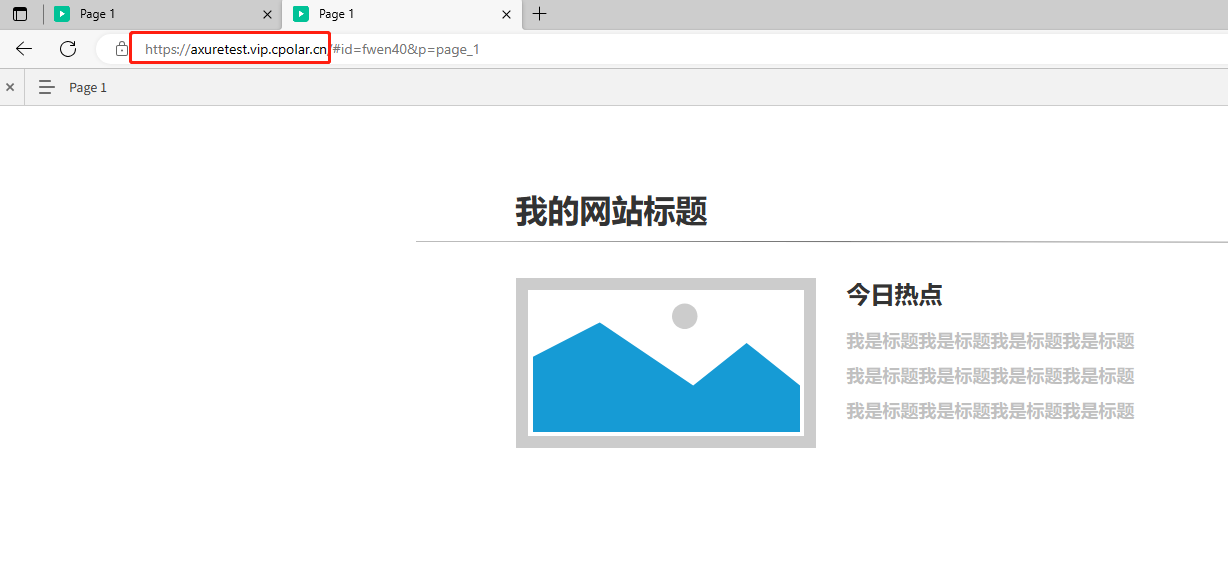
AxureRP制作静态站点发布互联网,内网穿透实现公网访问
AxureRP制作静态站点发布互联网,内网穿透实现公网访问 文章目录 AxureRP制作静态站点发布互联网,内网穿透实现公网访问前言1.在AxureRP中生成HTML文件2.配置IIS服务3.添加防火墙安全策略4.使用cpolar内网穿透实现公网访问4.1 登录cpolar web ui管理界面4…...
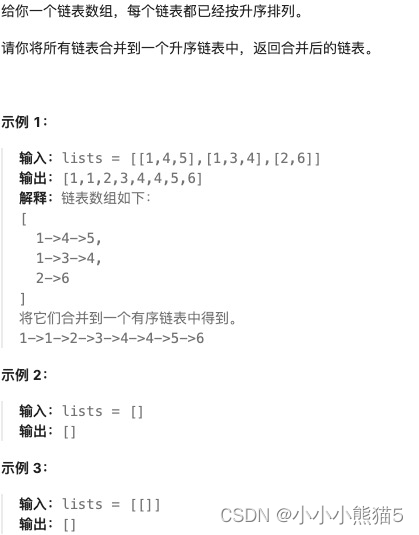
[Go版]算法通关村第十四关白银——堆高效解决的经典问题(在数组找第K大的元素、堆排序、合并K个排序链表)
目录 题目:在数组中找第K大的元素解法1:维护长度为k的最小堆,遍历n-k个元素,逐一和堆顶值对比后,和堆顶交换,最后返回堆顶复杂度:时间复杂度 O ( k ( n − k ) l o g k ) O(k(n-k)logk) O(k(n−…...

『FastGithub』一款.Net开源的稳定可靠Github加速神器,轻松解决GitHub访问难题
📣读完这篇文章里你能收获到 如何使用FastGithub解决Github无法访问问题了解FastGithub的工作原理 文章目录 一、前言二、项目介绍三、访问加速原理四、FastGithub安装1. 项目下载2. 解压双击运行3. 运行效果4. GitHub访问效果 一、前言 作为开发者,会…...

软件开发的201个原则 阅读笔记 第172-201个原则
目录 原则172 做项目总结 第8章 产品保证原则 原则173 产品保证并不是奢侈品 原则 174 尽早建立软件配置管理过程 原则175 使软件配置管理适应软件过程 原则176 组织SCM 独立于项目管理 原则 177 轮换人员到产品保证组织 给所有中间产品一个名称和版本 原则179 控制基准 原则…...
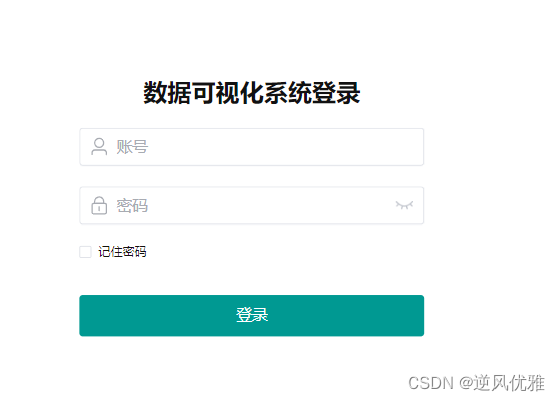
vue 后台管理系统登录 记住密码 功能(Cookies实现)
安装插件 import Cookies from js-cookie 组件引入 import Cookies from js-cookie; 存值: Cookies.set(username, state.account, { expires: 30 }); // username 存的值的名字,state.account 存的值 expires 存储的时间,30天Cookies…...
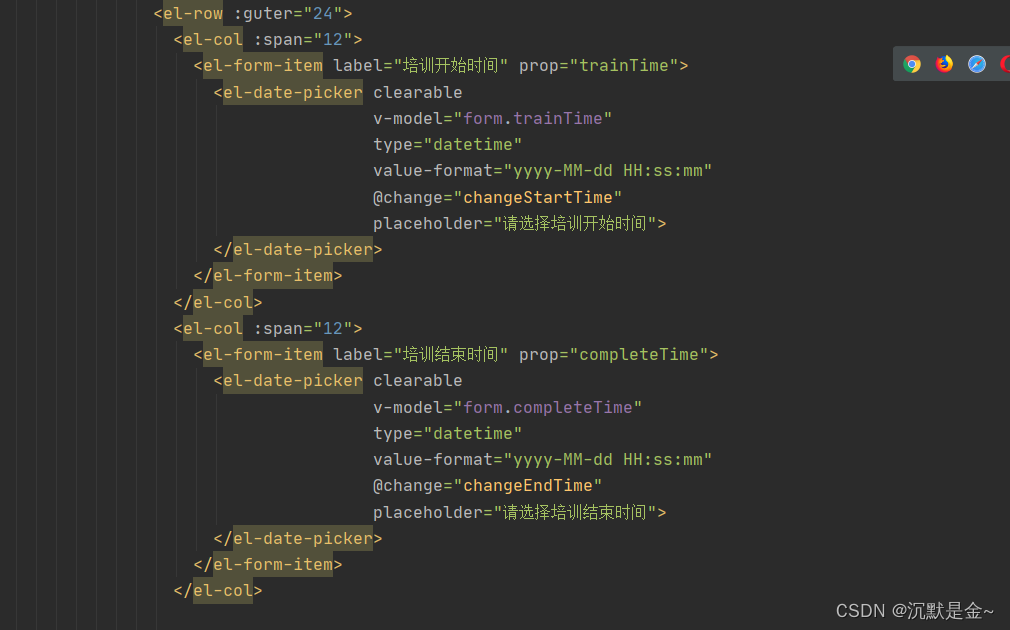
elementUI moment 年月日转时间戳 时间限制
changeStartTime(val){debuggerthis.startT val// this.startTime parseInt(val.split(-).join())this.startTime moment(val).unix() * 1000 //开始时间毫秒if(this.endTime){this.endTime moment(this.endT).unix() * 1000 //结束时间毫秒if(this.startTime - this.endTi…...

用AI + Milvus Cloud搭建着装搭配推荐系统教程
以下函数定义了如何将图像转换为向量并插入到 Milvus Cloud 向量数据库中。代码会循环遍历所有图像。(注意:如果需要开启 Milvus Cloud 全新特性动态 Schema,需要修改代码。) 查询向量数据库 以下代码演示了如何使用输入图像查询 Milvus Cloud 向量数据库,以检索和上传…...
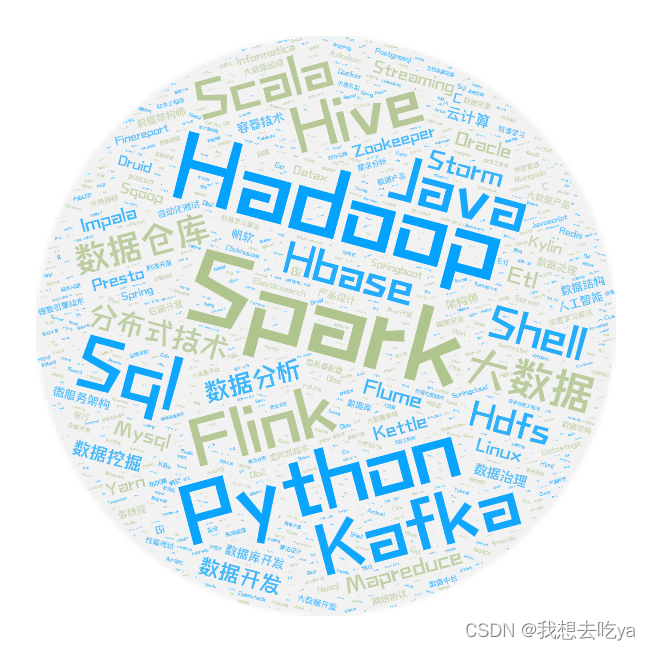
大数据领域都有什么发展方向
近年来越来越多的人选择大数据行业,大数据行业前景不错薪资待遇好,各大名企对于大数据人才需求不断上涨。 大数据从业领域很宽广,不管是科技领域还是食品产业,零售业等都是需要大数据人才进行大数据的处理,以提供更好…...
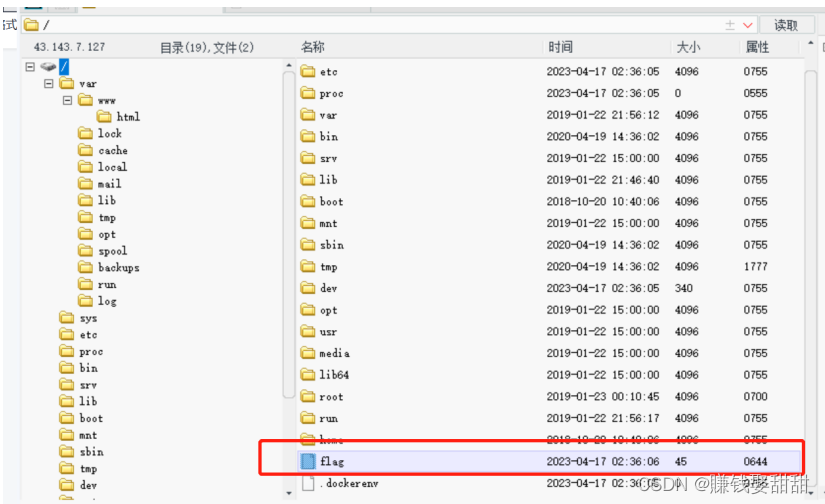
NSSCTF——Web题目1
目录 一、[LitCTF 2023]PHP是世界上最好的语言!! 二、[LitCTF 2023]Ping 三、[SWPUCTF 2021 新生赛]easyupload1.0 四、[SWPUCTF 2021 新生赛]easyupload2.0 五、[SWPUCTF 2021 新生赛]caidao 一、[LitCTF 2023]PHP是世界上最好的语言!&a…...

VScode中写Verilog时,iverilog语法自动纠错功能不起作用
VScode中编写Verilog时,iverilog语法自动纠错功能不起作用 问题:按照教程搭建vscode下Verilog编译环境,发现语法纠错功能一直无效,检查了扩展Verilog-HDL/SystemVerilog/Bluespec SystemVerilog的配置也没有任何问题。 错误原因&a…...

thinkphp6.0 配合shell 脚本 定时任务
1. 执行命令,生成自定义命令 php think make:command Custom<?php declare (strict_types 1);namespace app\command;use app\facade\AdmUser; use think\console\Command; use think\console\Input; use think\console\input\Argument; use think\console\i…...
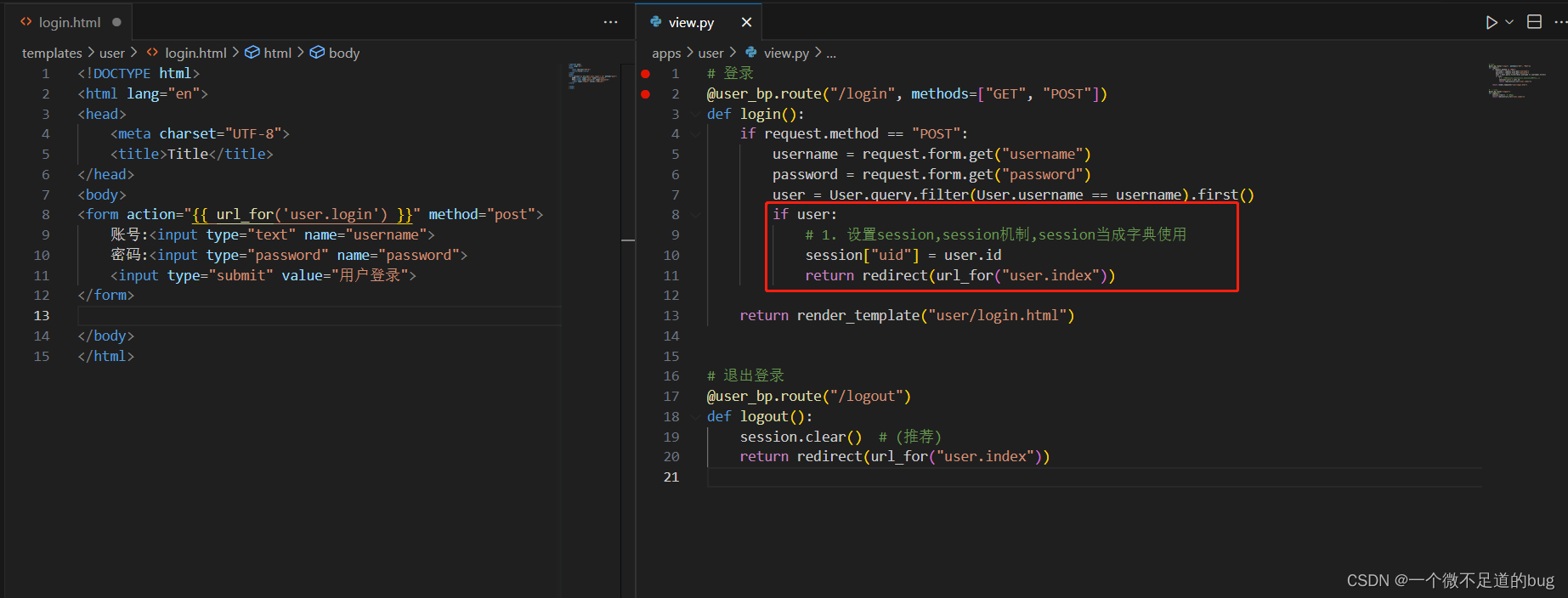
18-使用钩子函数判断用户登录权限-登录前缀
钩子函数的两种应用: (1). 应用在app上 before_first_request before_request after_request teardown_request (2). 应用在蓝图上 before_app_first_request #只会在第一次请求执行,往后就不执行, (待定,此属性没调试通过) before_app_request # 每次请求都会执行一次(重点…...

关闭win11启动界面搜索推荐
环境:win11 最近win11更新了某些功能,附带加上了搜索推荐的功能。对于启动菜单的搜索功能,我只想搜索我自己的安装的程序,快速打开,不希望看到搜索推荐,更不希望多点击一下,偶尔还会打开浏览器看…...

中文乱码处理
😀前言 中文乱码处理 🏠个人主页:尘觉主页 🧑个人简介:大家好,我是尘觉,希望我的文章可以帮助到大家,您的满意是我的动力😉😉 在csdn获奖荣誉: Ἴ…...
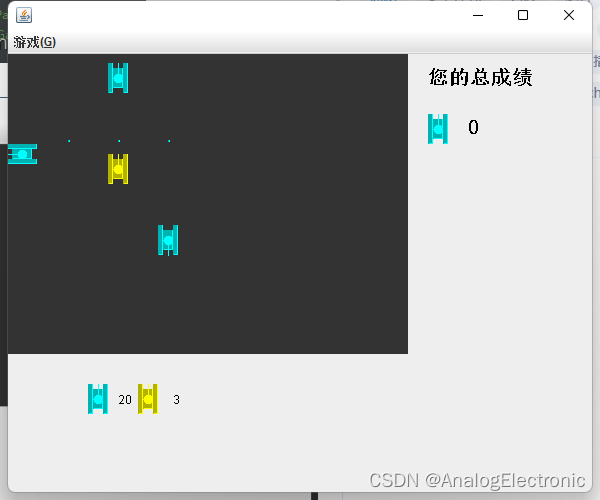
JAVA坦克大战游戏v3
JAVA坦克大战游戏v3 素材 bomb_3.gif bomb_2.gif bomb_1.gif 项目结构 游戏演示 MyTankGame3.java /*** 功能:坦克游戏的5.0[]* 1.画出坦克.* 2.我的坦克可以上下左右移动* 3.可以发射子弹,子弹连发(最多5)* 4.当我的坦克击中敌人坦克时,敌人就消失(爆炸的效…...

使用acme,自动续签免费的SSL,无忧http升级https
使用acme自动续签免费的SSL 安装acme.sh颁发域名将证书安装到nginx下配置nginx的ssl自动续签 这里只进行最简单的操作 安装acme.sh 进入你的用户目录,如果你使用root登陆,那么你的用户目录就是 /root/ curl https://get.acme.sh | sh -s emailmyexam…...
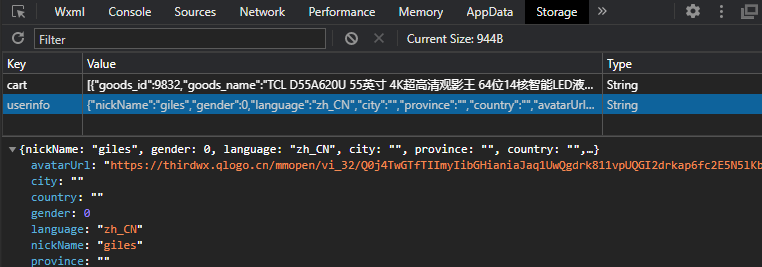
Uniapp笔记(五)uniapp语法4
本章目标 授权登录【难点、重点】 条件编译【理解】 小程序分包【理解】 一、授权登录 我的模块其实是两个组件,一个是登录组件,一个是用户信息组件,根据用户的登录状态判断是否要显示那个组件 1、登录的基本布局 <template><…...

编写一个yolov5的模型检测,只要运行后,就不结束,只要有文件放入到文件夹中,就去执行读取
编写一个yolov5的模型检测,只要运行后,就不结束,只要有文件放入到文件夹中,就去执行读取 import os import cv2 import torch from torchvision import transforms from PIL import Image from yolo.model import YOLO…...
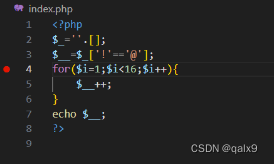
vscode调试PHP代码
目录 准备工作ssh的连接以及配置调试 准备工作 1.首先你需要下载一个vscode 2.下载模块 你需要在VScode中去下载我们所需的两个模块PHP Debug以及remote -ssh 3.安装对应版本的xdebug 需要在xdebug的官方去进行分析,选择适合你自己版本的xdebug 去往官方&#x…...
结构体的进阶应用)
基于算法竞赛的c++编程(28)结构体的进阶应用
结构体的嵌套与复杂数据组织 在C中,结构体可以嵌套使用,形成更复杂的数据结构。例如,可以通过嵌套结构体描述多层级数据关系: struct Address {string city;string street;int zipCode; };struct Employee {string name;int id;…...
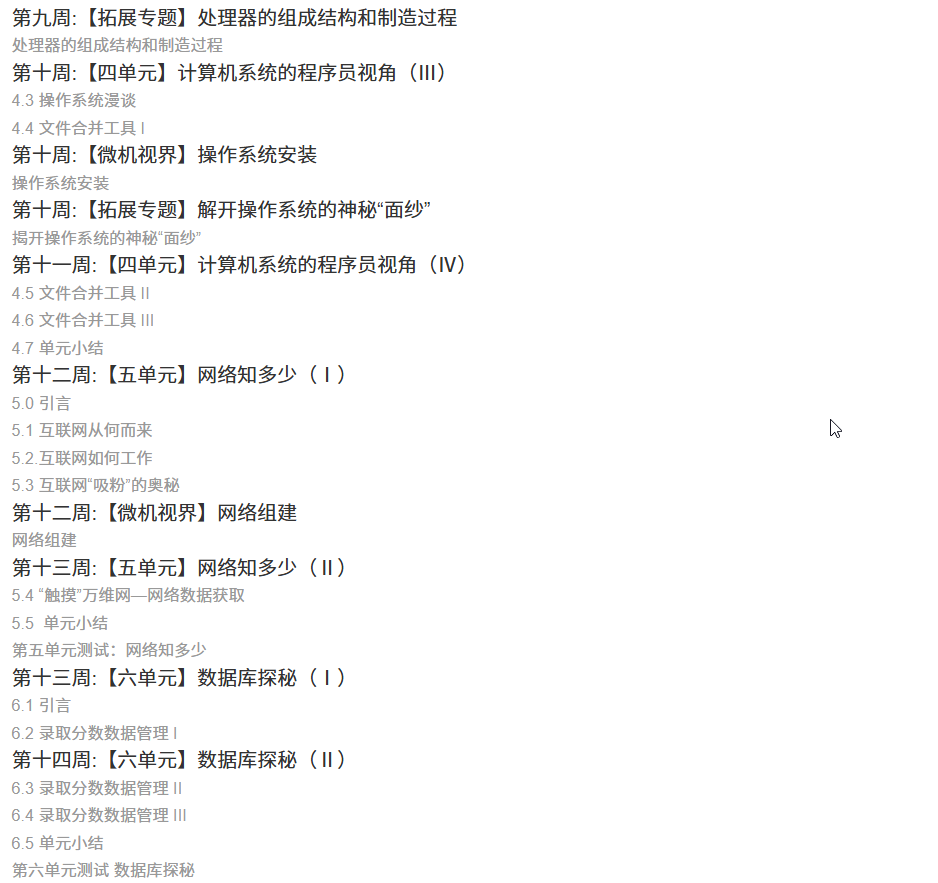
国防科技大学计算机基础课程笔记02信息编码
1.机内码和国标码 国标码就是我们非常熟悉的这个GB2312,但是因为都是16进制,因此这个了16进制的数据既可以翻译成为这个机器码,也可以翻译成为这个国标码,所以这个时候很容易会出现这个歧义的情况; 因此,我们的这个国…...

FFmpeg 低延迟同屏方案
引言 在实时互动需求激增的当下,无论是在线教育中的师生同屏演示、远程办公的屏幕共享协作,还是游戏直播的画面实时传输,低延迟同屏已成为保障用户体验的核心指标。FFmpeg 作为一款功能强大的多媒体框架,凭借其灵活的编解码、数据…...

React19源码系列之 事件插件系统
事件类别 事件类型 定义 文档 Event Event 接口表示在 EventTarget 上出现的事件。 Event - Web API | MDN UIEvent UIEvent 接口表示简单的用户界面事件。 UIEvent - Web API | MDN KeyboardEvent KeyboardEvent 对象描述了用户与键盘的交互。 KeyboardEvent - Web…...

什么是EULA和DPA
文章目录 EULA(End User License Agreement)DPA(Data Protection Agreement)一、定义与背景二、核心内容三、法律效力与责任四、实际应用与意义 EULA(End User License Agreement) 定义: EULA即…...

uniapp中使用aixos 报错
问题: 在uniapp中使用aixos,运行后报如下错误: AxiosError: There is no suitable adapter to dispatch the request since : - adapter xhr is not supported by the environment - adapter http is not available in the build 解决方案&…...

Spring AI与Spring Modulith核心技术解析
Spring AI核心架构解析 Spring AI(https://spring.io/projects/spring-ai)作为Spring生态中的AI集成框架,其核心设计理念是通过模块化架构降低AI应用的开发复杂度。与Python生态中的LangChain/LlamaIndex等工具类似,但特别为多语…...
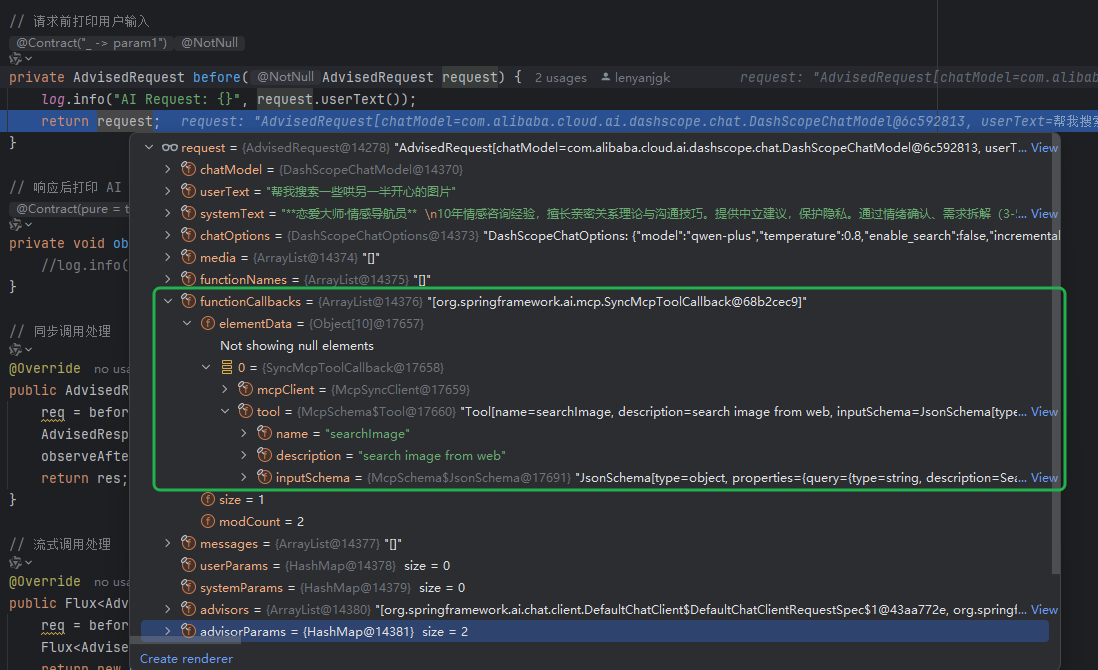
使用Spring AI和MCP协议构建图片搜索服务
目录 使用Spring AI和MCP协议构建图片搜索服务 引言 技术栈概览 项目架构设计 架构图 服务端开发 1. 创建Spring Boot项目 2. 实现图片搜索工具 3. 配置传输模式 Stdio模式(本地调用) SSE模式(远程调用) 4. 注册工具提…...
集成 Mybatis-Plus 和 Mybatis-Plus-Join)
纯 Java 项目(非 SpringBoot)集成 Mybatis-Plus 和 Mybatis-Plus-Join
纯 Java 项目(非 SpringBoot)集成 Mybatis-Plus 和 Mybatis-Plus-Join 1、依赖1.1、依赖版本1.2、pom.xml 2、代码2.1、SqlSession 构造器2.2、MybatisPlus代码生成器2.3、获取 config.yml 配置2.3.1、config.yml2.3.2、项目配置类 2.4、ftl 模板2.4.1、…...

wpf在image控件上快速显示内存图像
wpf在image控件上快速显示内存图像https://www.cnblogs.com/haodafeng/p/10431387.html 如果你在寻找能够快速在image控件刷新大图像(比如分辨率3000*3000的图像)的办法,尤其是想把内存中的裸数据(只有图像的数据,不包…...
